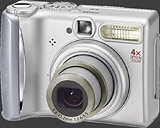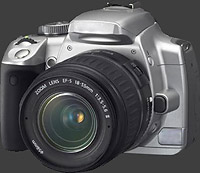This article isn't yet public on the main site, but I thought I'd release it here first. It's a really important topic that hasn't yet been discussed anywhere in this site's tutorials.
Tutorial: Compact vs Digital SLR Cameras
I think you'll also find that the tutorial takes on this topic from a different angle than you may have seen discussed elsewhere. It starts out by focusing on the three most common/important differences: the viewfinder, potential for different lenses and sensor size. It then discusses the implications of each for photography.
As usual, please let me know if you feel anything is unclear, if you notice any typos or just want to add something from your own experience.
Many thanks!
Results 1 to 10 of 10
-
10th December 2010, 09:24 PM #1Administrator

- Join Date
- Apr 2008
- Location
- California, USA
- Posts
- 1,473
- Real Name
- Sean
New Tutorial: Compact vs. Digital SLR Cameras
-
10th December 2010, 10:53 PM #2
Re: New Tutorial: Compact vs. Digital SLR Cameras
Didn't see any typos, and a good clear article! I like it.
One main thing that I think might require additional emphasis earlier on, although it's addressed and more or less understood, is the high cost involved in a dSLR system overall. This tends to be as much or more of a deciding factor on someone going dSLR than the photographic advantages. Most newbies who are looking to get their first dSLR are still thinking from a P&S point-of-view that the camera is a self-contained system. They just see that the camera kit costs X amount more than a P&S camera and persist in thinking of a dSLR as an upgrade. But it's more of a paradigm switch from a camera to a camera system. I tend to make the analogy to newbies that a P&S camera is like a swiss army knife, while a dSLR is more like a big red tool box: and you still have to buy the tools to go in it. The camera body is only the base cost to get into dSLR photography.
Now for the completely ignorable minor nitpicks.
Minor nitpick 1: Is the DoF preview button on a dSLR really an "advantage" on the dSLR side? Especially since the entry level Nikons don't have one.
Minor nitpick 2: No mention of a flash hotshoe as an advantage? Extensibility of the camera system is addressed, though, so probably unneeded.
Extensibility of the camera system is addressed, though, so probably unneeded.
Minor nitpick 3: The idea that a larger sensor alone automatically confers a thinner DoF is a little misleading, because it's also a combination of the larger sensor and longer/bigger lenses. One of the reasons P&S cameras have the deep DoF they do is because the focal length of a P&S lens at the wide end is in the 5-10mm range. The fact that moving to a dSLR loses you "macro mode" is part of this. Larger sensor -> larger lenses -> larger minimum focus distance -> smaller DoF. Also the loss of the "superzoom" capabilities a 6x crop factor gave you on a bridgecam. Another P&S-think concept you may want to address is the difference between a zoom factor and focal length.
Minor nitpick 4: The Fujifilm F300EXR P&S uses phase-detection autofocus. Probably not an issue, but if other P&S cameras pick it up, maybe the faster autofocus on a dSLR might not be an advantage any more.
Minor nitpick 5: I like "photosites/pixels", but some folks are using "sensels" to clarify the concept.
-
10th December 2010, 11:57 PM #3Administrator

- Join Date
- Apr 2008
- Location
- California, USA
- Posts
- 1,473
- Real Name
- Sean
Re: New Tutorial: Compact vs. Digital SLR Cameras
Thanks for all the feedback! Please see below:
I've added a paragraph in the overview section to address this up-front.
I just removed this one since it's really minor in the context of the others.
I do mention that SLR cameras can use an external flash unit, so I guess the hotshoe part is implicit. It's only mentioned toward the end in the "other differences" section.
Yes, this is a complicated relationship. The goal would be to keep it as simple as possible in this article, but have them visit the camera sensor sizes tutorial if the reader needs to learn more. I should mention more about the combined effect of though.
I added a parenthetical in the "other differences" section. I do have a catch-all qualifier in the last paragraph of that section though, which says that one can obtain most of the above SLR differences if they purchase a high-end compact model.
Thanks again...Last edited by McQ; 20th December 2010 at 07:26 AM.
-
11th December 2010, 01:26 AM #4
Re: New Tutorial: Compact vs. Digital SLR Cameras
You're welcome! I'm a techwriter by profession, so I pick text apart for a living.

Looks great! You hit all the points and were clear and concise.Re: Additional cost of the system
I've added a paragraph in the overview section to address this up-front.
Yup. It feel a little 'reachy'.Re: DoF preview button
I just removed this one since it's really minor in the context of the others.
It's a minor thing, and in retrospect you're probably right to leave it alone--the deep deep rabbit hole that is flash photography is too big to comfortably footnote or summarize, and, as you say, the picture's complicated enough already on a subject like this.Re: flash hotshoe
I do mention that SLR cameras can use an external flash unit, so I guess the hotshoe part is implicit. It's only mentioned toward the end in the "other differences" section.
Eh, as I said, it's a minor nitpick. For me, it's the practical outcome of losing the supertelephoto reach of a bridgecam, or the expected "macro mode" on a dSLR that can trip up a newbie. But, again, as points go, this one's minor.Yes, this is a complicated relationship. The goal would be to keep it as simple as possible in this article, but have them visit the camera sensor sizes tutorial if the reader needs to learn more. I should mention more about the combined effect of though.
I think the catchall's more than sufficient and deleting the parenthetical on the autofocus bullet is fine. Too many parentheticals and you can lose track of the thought.Fuji F300EXR
I added a parenthetical in the "other differences" section. I do have a catch-all qualifier in the last paragraph of that section though, which says that one can obtain most of the above SLR differences if they purchase a high-end compact model. Also, AFAIK, the Fuji's the only one that does this (so far).
Also, AFAIK, the Fuji's the only one that does this (so far).
Last edited by McQ; 20th December 2010 at 07:25 AM.
-
11th December 2010, 12:43 PM #5
Re: New Tutorial: Compact vs. Digital SLR Cameras
Nice article, you mentioned the difference in weight of each camera type but did not mention the need to stabilize the DSLR for sharper images more than the compact.
Last edited by McQ; 11th December 2010 at 05:52 PM.
-
12th December 2010, 05:20 PM #6Administrator

- Join Date
- Apr 2008
- Location
- California, USA
- Posts
- 1,473
- Real Name
- Sean
Re: New Tutorial: Compact vs. Digital SLR Cameras
Hi John, thanks for the feedback. It's really a mixed bag when it comes to which needs stabilization more. One could argue that for average use (where depth of field doesn't need to be maximized), that an SLR actually needs much less stabilization because it has the advantage of (i) having larger aperture lenses available and (ii) having higher ISO speeds at the same quality level. However, for the same depth of field and print resolution, then an SLR will indeed have longer exposure times -- but one could also argue that in situations where depth of field is most important (landscapes), one should be using a tripod anyway.
-
12th December 2010, 11:29 PM #7

- Join Date
- Apr 2010
- Location
- Virginia USA
- Posts
- 51
- Real Name
- Alan Pezzulich
Re: New Tutorial: Compact vs. Digital SLR Cameras
Good article except for the first part on viewfinders. I don't think there are any compact cameras that use optical viewfinders. By switching to live view it is the point and shoots that show what is actually hitting the sensor while the SLR cameras have two different paths for the image to take, one for the viewfinder and one for the sensor. The differnce should be negligable, but technically the live view camera is better. A problem with most point and shoots is that while what is being displayed on the screen is potentially more accurate it is often the case that sunlight will render the view screen on the back of the camera almost useless.
Alan
-
16th December 2010, 05:28 PM #8New Member

- Join Date
- Nov 2010
- Location
- Old Reynella, South Australia
- Posts
- 3
- Real Name
- Des Crocker
Re: New Tutorial: Compact vs. Digital SLR Cameras
Hi, being an absolute novice to digital photography and if I were to be considering entering into the realm of this artform then as a discussion instrument to help understand the "basic" differences then I think this article is "on the button". I own a p&s (which my wife uses exclusively) and a dSLR which for me satisfies the personal need for "things technical". Anybody deciding to undertake any pursuit generally will eventually need to "find out a bit more" and in that sense I believe the links embedded in the article as indeed with all of your work enable a potentially discerning person to find that little extra info.
Well done ... oh, and no booboos that I could see ...hope there are none in this response.
ecna
-
16th December 2010, 10:46 PM #9Administrator

- Join Date
- Apr 2008
- Location
- California, USA
- Posts
- 1,473
- Real Name
- Sean
Re: New Tutorial: Compact vs. Digital SLR Cameras
Hi Alan -- thanks for the feedback. I have a couple of compacts that have optical viewfinders, so I wanted to address that topic for others who are in the same boat. As you say though, live view is in many ways superior since it shows the image as it will actually be captured, and thus mostly negates any potential disadvantage of having a non-slr type viewfinder.
-
16th December 2010, 10:50 PM #10Administrator

- Join Date
- Apr 2008
- Location
- California, USA
- Posts
- 1,473
- Real Name
- Sean

 Helpful Posts:
Helpful Posts: 


 Reply With Quote
Reply With Quote

